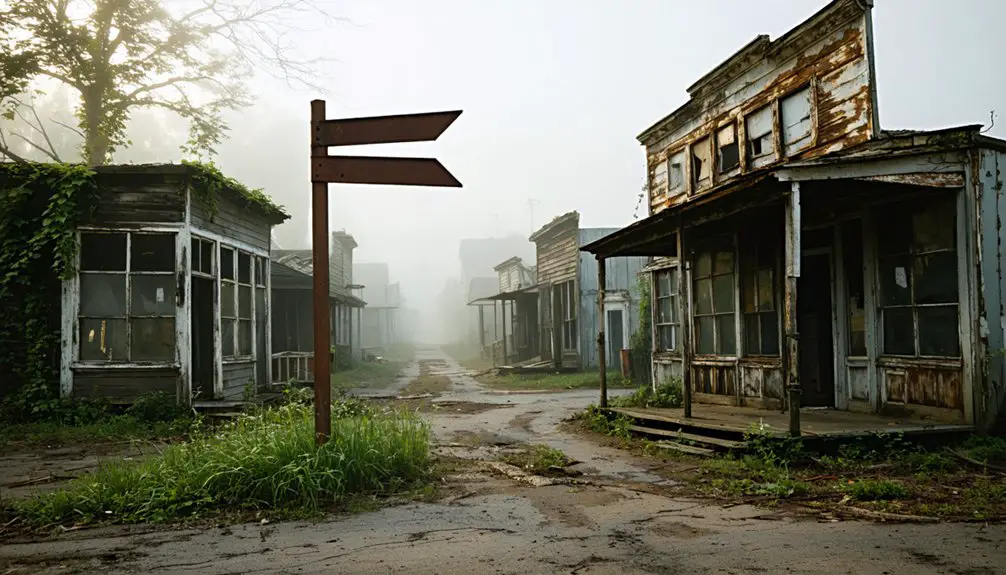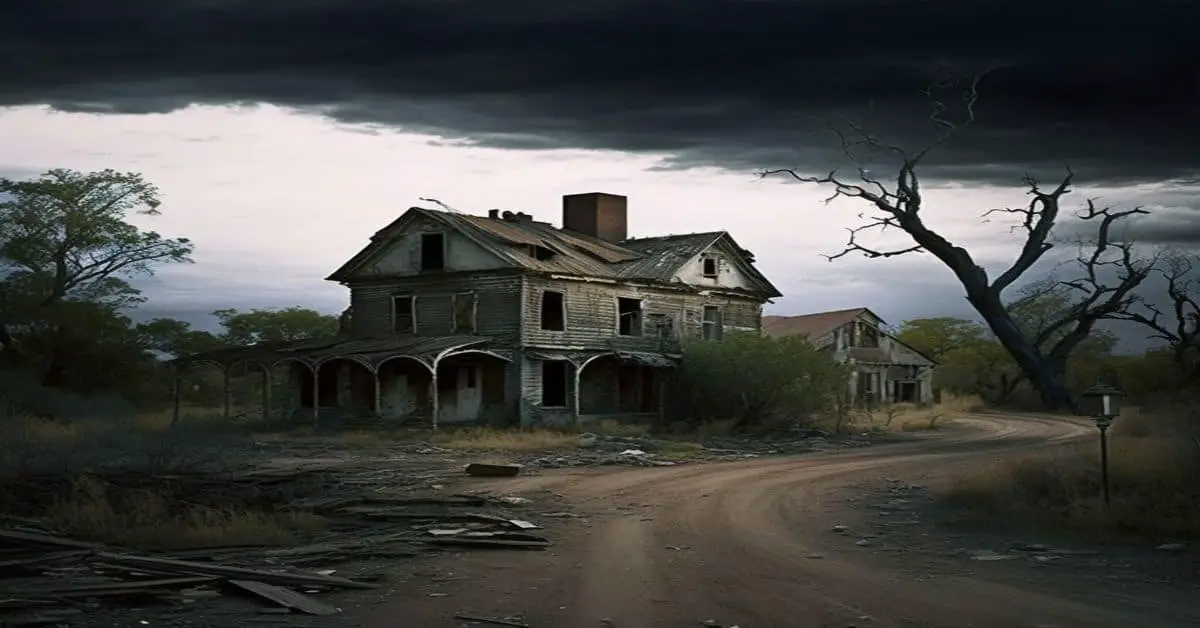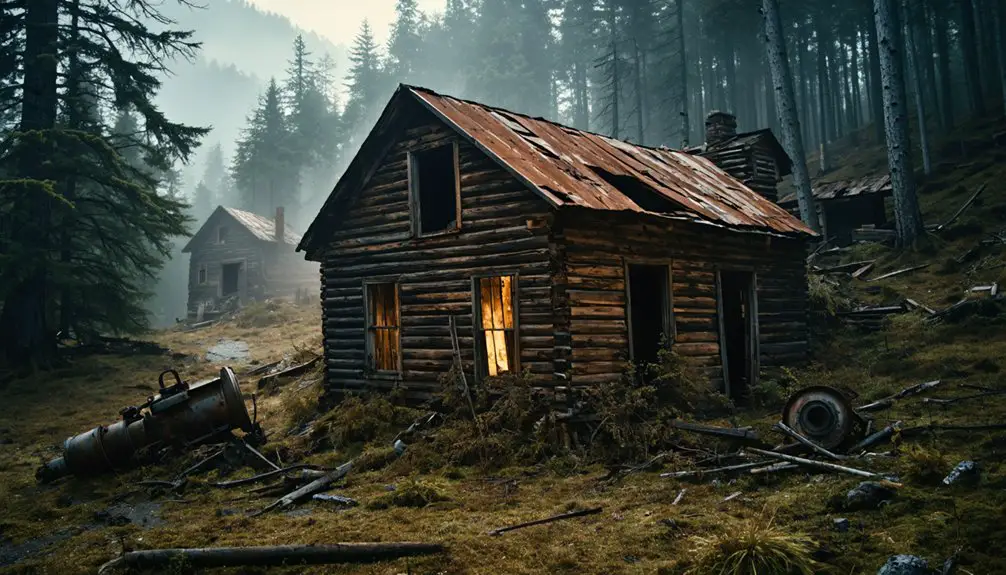You’ll find the remnants of Davis, a once-thriving coal mining town, in western Maryland’s remote corners. Founded by Henry Gassaway Davis after the Civil War, this company town peaked in the 1930s with 900 residents, complete with an opera house, churches, and carefully planned neighborhoods. After the mines closed in 1950, environmental damage and economic decline forced residents to abandon their homes. Today, nature reclaims the ghostly ruins while paranormal tales echo through the abandoned mine shafts.
Key Takeaways
- Davis was a thriving coal mining town in Maryland that peaked at 900 residents during the 1930s before its eventual abandonment.
- The town’s decline began with the closure of Kempton Mine in 1950, leading to mass exodus and economic collapse.
- Residents were forced to evacuate by 1968, with the Daniels Company systematically demolishing buildings and infrastructure.
- Hurricane Agnes delivered a final blow in 1972, devastating what remained of the community’s structures.
- Nature has reclaimed the town site, with vegetation overtaking former residential areas and paranormal activity reported in abandoned mines.
The Birth of a Company Town
When Henry Gassaway Davis shifted from his railroad career to coal mining after the Civil War, he laid the groundwork for what would become the Davis Coal & Coke Company. The company’s origins began with strategic land acquisitions across Mineral, Grant, Tucker, and Randolph counties in the late 1860s, establishing a foundation for future mining expansion.
You’ll find the company’s first significant development took place in 1882 near Piedmont, WV, where Davis launched initial mining operations and railroad construction. By 1886, the venture had unified under the Davis Coal and Coke Company name. The discovery of the rich Kittaning seam in 1884 propelled the company’s rapid growth in the region.
The enterprise grew to encompass several company towns, including Davis, Thomas, and Coketon. These settlements featured worker housing, commercial facilities, and extensive mining infrastructure, all supported by Davis’s integrated network of railroads that enabled efficient coal transport and regional development. The company’s US Navy ships relied heavily on the coal produced at these mines until operations ceased in 1950.
Life in Davis’s Mining Community
Life in Davis revolved around carefully planned neighborhoods where the Davis Coal & Coke Company provided 4-6 room houses arranged along two main streets.
The Davis Coal & Coke Company shaped community life through its strategic housing layout, offering modest homes along parallel streets.
You’d find diverse community dynamics as eastern European, Lithuanian, Italian, Anglo-Saxon, and German families lived side by side, tending to their front yards and back gardens.
The town’s immigrant integration centered around shared spaces where you could gather. The opera house served as your entertainment hub, offering bowling, pool, dancing, and a post office. The red brick building served multiple functions for both business and leisure activities.
You’d shop at the company store and send your children to the local school, established in 1915. Workers could only use company scrip for purchases, limiting their economic freedom. While mining work was grueling, you’d find relief in recreational activities and religious services at the Methodist church.
Your family’s economic well-being depended entirely on the mining operations’ success.
Underground Operations and Environmental Impact
Deep beneath Davis’s streets, you’d find an intricate network of mining shafts reaching 420 feet into the Upper Freeport coal vein. The Davis Coal & Coke Company operated three main shafts: one for miners, one for coal extraction, and one for ventilation to combat dangerous underground gases. Similar to the man-made lakes at Fort Richie, the mining operations heavily impacted the local water resources.
You’ll discover the mining operation’s dark legacy in the surrounding environment. Untreated water discharge poisoned local streams, destroying native trout populations. The mining created unstable ground conditions and underground hazards, while spoil heaps scarred the landscape. Like the child labor during the Gary family era, the mining industry’s practices showed little regard for human welfare.
Mining pollution continued long after operations ceased in 1950, with acid drainage and heavy metals contaminating groundwater. Even today, you can see the effects: abandoned shafts dot the terrain, streams show reduced biodiversity, and vegetation struggles to reclaim the disturbed earth.
Daily Life and Social Infrastructure
Throughout its heyday, Davis supported a vibrant community infrastructure centered around company-owned facilities and services. You’d find about 90 families living across 118 homes spread over 500 acres, all under Daniels Company ownership. The name Daniels required careful disambiguation efforts to distinguish it from other similarly named locations.
The general store served as your primary hub for supplies and community gatherings, while three churches, including Saint Stanislaus Kostka Catholic Church, provided spiritual guidance. The property was previously known as Alberton in 1853 before the Daniels Company acquired it.
For recreational activities, you could enjoy the bowling alley, pool hall, or ball field. The town’s library offered educational resources, and a restaurant provided a social dining spot.
Essential services included a water system, postal service, and private roads. Though company-controlled, these amenities fostered a tight-knit community until mandatory relocation notices arrived in 1968.
The Final Days of Mining
When mining operations began at the Kempton Mine in 1915, you’d witness the daily extraction of 250-300 tons of coal from the Upper Freeport Seam.
By 1922, it had become Maryland’s most modern coal operation, supporting up to 900 residents during its peak in the 1930s.
The Kempton Mine’s modernization transformed it into a thriving industrial hub, becoming home to nearly a thousand people by the 1930s.
The final mining operations in 1950 marked dramatic changes:
- Production ceased unexpectedly, triggering rapid economic decline
- Workers and their families left town as jobs disappeared
- Community resilience couldn’t overcome the broader post-WWII drop in coal demand
- The mine’s closure left devastating environmental impacts, including acid drainage
Before its decline, Kempton was praised as a model company town by mine operators.
You’ll find that Kempton’s swift transformation from a thriving coal town to abandonment exemplifies the volatile nature of mining-dependent communities. Much like the historic Maryland Mine explosion of 1906, these mining operations faced serious hazards that impacted their longevity.
The once-bustling operation now stands as a reflection of the boom-and-bust cycle of Appalachian coal towns.
Abandonment and Decay
You’ll find that Davis’s abandonment began sharply in 1968 when the Daniels Company announced the closure of mill housing, prompting 150 residents to quickly relocate.
The company’s systematic demolition of buildings, coupled with natural disasters like Tropical Storm Agnes in 1972, accelerated the town’s physical deterioration and left only scattered ruins.
Today, nature has thoroughly reclaimed the former industrial town, with vegetation overtaking the remaining foundations, rusting vehicles, and crumbling structures that dot the landscape within Patapsco Valley State Park.
Rapid Population Exodus
As financial troubles plagued the mill company in the mid-1960s, Davis, Maryland began its swift descent into abandonment.
The population displacement accelerated due to multiple economic factors, leaving residents with no choice but to relocate.
You’ll find the exodus unfolded through four decisive events:
- The company issued mandatory evacuation orders, giving residents just one year to leave their homes.
- The mill’s financial decline eliminated jobs and destroyed the town’s economic foundation.
- The closure of company-owned facilities, including stores and essential services, made daily life unsustainable.
- Hurricane Agnes’s devastating floods in 1972 delivered the final blow, destroying what remained of the community.
The town’s fate was sealed when state agencies acquired the ruined property, transforming it into parkland.
Deteriorating Company Buildings
Following the exodus of Davis’s residents, the town’s buildings began a steady descent into ruin through a combination of neglect, natural disasters, and human interference.
The closure of the textile mill in the late 1960s triggered widespread abandonment of C.R. Daniels Company properties, leaving dilapidated facades to crumble under nature’s persistent force.
Tropical Storm Agnes dealt a devastating blow in 1972, destroying many remaining structures and making restoration financially impossible.
You’ll find stone foundations and decaying wooden frames where homes once stood, while the historical significance of sites like Saint Stanislaus Kostka Church is preserved only in its ruins and small graveyard.
Though the Maryland Department of Natural Resources now manages the area within Patapsco Valley State Park, most structures remain in arrested decay, silent witnesses to the town’s industrial past.
Nature Reclaims Town
Since Davis’s abandonment, nature has steadily reclaimed the town’s footprint through an aggressive ecological succession.
You’ll witness nature’s resilience as vegetation engulfs former residential lots and commercial spaces, transforming them into an urban wilderness where wildlife now thrives.
The town’s transformation includes:
- Trees, shrubs, and wild plants dominating former yards and gardens
- Moss and weeds obscuring roads and sidewalks beneath thick vegetation
- Vines and roots infiltrating building foundations, accelerating structural decay
- Natural wetlands restoring themselves along riverbanks
Wildlife has established new habitats in abandoned structures, while soil naturally regenerates through organic matter accumulation.
The elements continue their relentless assault on remaining structures, with seasonal freeze-thaw cycles and flooding hastening their return to nature.
Paranormal Tales From the Mines
While the abandoned mines of Davis, Maryland stand as silent monuments to the region’s industrial past, they harbor some of the area’s most chilling paranormal accounts.
You’ll find ghostly encounters range from unexplained tool disappearances to terrifying sightings of spectral miners with fiery eyes deep in the tunnels. Even horses refuse to approach certain areas, suggesting an otherworldly presence.
Night watchmen report mysterious knockings echoing through shaft walls, while witnesses describe phantom voices calling out names like “Priscilla.”
The mines’ dark history of tragic accidents, unsolved deaths, and numerous child graves in nearby cemeteries fuels these haunting tales.
Most unsettling are the appearances of the “ghost bricklayer,” an African American figure who silently works before vanishing into thin air.
Legacy of Maryland’s Coal Heritage
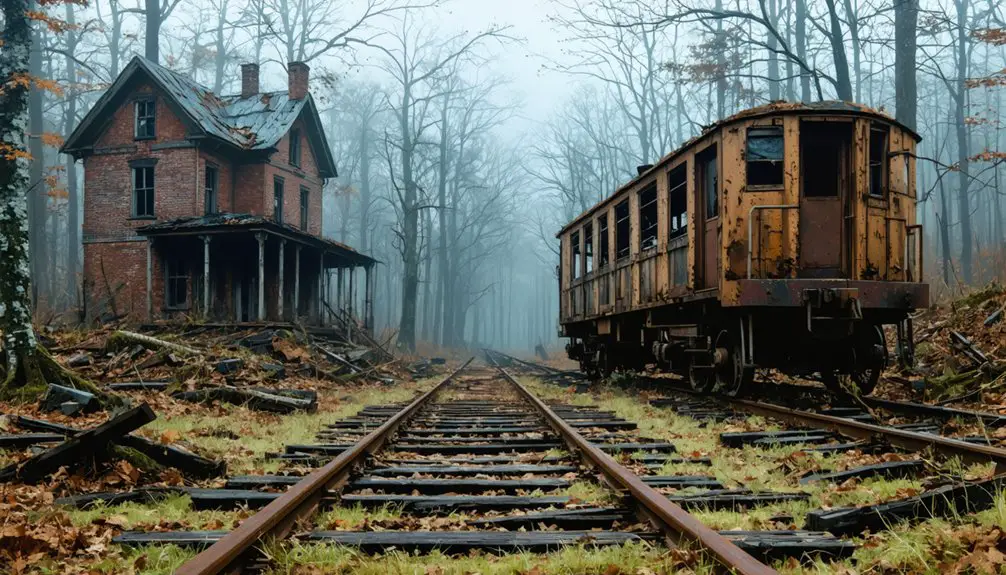
The industrial legacy of Maryland’s coal mining stretches back to the 1780s, marking generations of economic transformation across the state’s western regions.
Maryland’s rich coal mining heritage began nearly two centuries ago, forever changing the economic landscape of its western frontier.
You’ll find this heritage reflected in Western Maryland’s development through:
- Railroad expansion in the 1840s that drove production from 1 million tons in 1865 to a peak of 5.5 million tons by 1907
- Well-paid mining jobs that supported thousands of workers, with Allegany County employing 5,778 miners at its height in 1910
- The formation of company towns and communities like Davis, which grew around mining operations
- Digital preservation of over 500 historic mine maps and 125 years of Bureau reports
This economic transformation shaped Western Maryland’s identity, though production declined after 1920 as petroleum gained prominence, forcing communities to diversify their economies.
Exploring Davis Today
Nestled in the remote reaches of Garrett County, Davis stands today as a haunting reminder of Maryland’s coal mining past.
You’ll find this ghost town exploration reveals crumbling company houses, roofless ruins, and scattered foundations slowly being reclaimed by Appalachian forest. The site offers no formal facilities, so you’ll need to navigate carefully through uneven terrain and overgrown paths.
As you explore, you’ll witness signs of ecological recovery, where nature gradually heals the industrial scars. Former mine shafts, water runoff sites, and remnants of mining equipment dot the landscape.
While local streams show improvement from historical pollution, they still bear the impact of the town’s mining legacy. Wildlife has returned to the area, making Davis an intriguing study in post-industrial regeneration.
Preserving a Forgotten Past
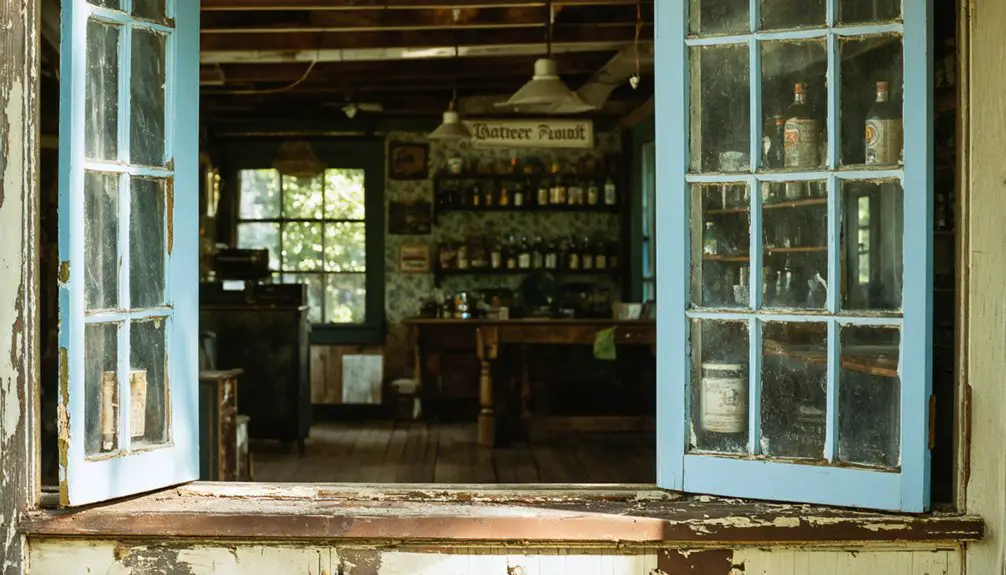
Preservation efforts in Davis have gained momentum through coordinated initiatives between historical organizations and community volunteers.
You’ll find preservation strategies focused on protecting the town’s remaining structures while documenting its rich heritage for future generations.
Local preservation societies have implemented these key actions:
- Securing grant funding from state programs to stabilize historic ruins
- Organizing volunteer cleanup events to clear overgrowth from historic foundations
- Installing interpretive markers that detail Davis’s economic significance
- Creating educational materials that highlight indigenous, settler, and African American histories
Community engagement remains central to these preservation efforts, with historical societies hosting marker dedication ceremonies and distributing informational brochures.
You can participate in ongoing restoration projects that guarantee Davis’s story endures through both physical preservation and cultural memory.
Frequently Asked Questions
What Happened to the Mining Equipment After Davis Was Abandoned?
Like Pompeii’s relics, you’ll find most abandoned machinery deteriorated in place, while locals salvaged valuable metal parts. Some artifacts made it to historical preservation sites, but most equipment simply rusted away.
Are There Any Surviving Maps of the Underground Mine Tunnels?
You’ll find digitized historical tunnel maps through Maryland’s Coal Mine Mapping Project, which preserves underground mining records. The state’s preservation efforts maintain these significant documents in GIS databases and archives.
Did Any Original Davis Residents Return to Live There?
Like scattered leaves never returning to their branch, no original residents came back to Davis. Historical records show the ghost town remained abandoned after the 1950 mine closure.
What Wildlife Now Inhabits the Abandoned Mine Shafts?
You’ll find thriving bat colonies inhabiting the mine’s tunnel ecosystems, with little brown and big brown bats using the shafts for winter hibernation and summer maternity colonies.
Were There Any Documented Mining Accidents or Disasters in Davis?
Like a grim chapter in an old dusty ledger, you’ll find historical records show two major mining accidents: the 1916 Davis No. 42 explosion killing 16 men, and a 2007 highwall collapse claiming two miners’ lives.
References
- https://visitmontgomery.com/blog/see-do/montgomery-county-mysterious-and-haunted-places-road-trip/
- http://allenbrowne.blogspot.com/2012/03/upper-potomac-ghost-town-in-southwest.html
- https://tourbaltimoreghosts.com/the-beall-dawson-house/
- https://www.youtube.com/watch?v=sbFq0i5w0-c
- https://bethesdamagazine.com/2023/10/13/5-ghost-stories-from-montgomery-county/
- https://theclio.com/entry/61643
- https://www.calvertmarinemuseum.com/DocumentCenter/View/3181/MMDavis_BugeyeTimes
- https://historicthomaswv.org/coal-industry
- https://archives.lib.umd.edu/repositories/2/resources/961
- https://kemptonarchaeology.com
